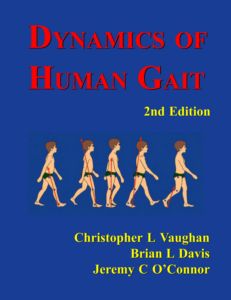This book was created as a companion to the GaitLab software package. Our intent was to introduce gait analysis, not to provide a comprehensive guide. We try to serve readers with diverse experience and areas of interest by discussing the basics of human gait as well as some of the theoretical, biomechanical, and clinical aspects.
In chapter 1 we take you in search of the homunculus, the little being inside each of us who makes our walking patterns unique. We represent the walking human as a series of interconnected systems -- neural, muscular, skeletal, mechanical, and anthropometric -- that form the framework for detailed gait analysis.
The three-dimensional and cyclical nature of human gait is described in chapter 2. We also explain how many of the relevant parameters can be expressed as a function of the gait cycle, including kinematics (e.g., height of lateral malleolus), kinetics (e.g., vertical ground reaction force), and muscle activity (e.g., EMG of rectus femoris).
In chapter 3 we show you how to use the framework constructed in the first two chapters to integrate anthropometric, 3-D kinematic, and 3-D force plate data. For most readers this will be an important chapter -- it is here that we suggest many of the conventions we believe to be lacking in three- dimensional gait analysis. Although conceptually rigorous, the mathematical details are kept to a minimum to make the material accessible to all students of human motion. (For the purists interested in these details, that information is in Appendix B.)
In chapter 4 we describe the basics of electromyography (EMG) and how it reveals the actions of the various muscle groups. We discuss some of the techniques involved and then illustrate the phasic behaviour of muscles during the gait cycle and describe how these signals may be statistically analysed. One of the purposes of this book is to help clinicians assess the gaits of their patients. Chapter 5 presents a case study of a 23 year-old-man with cerebral palsy. We have a complete set of 3-D data for him that can be processed and analyzed in GaitLab.
Beginning in Appendix A we use illustrated animation sequences to emphasize the dynamic nature of human gait. By carefully fanning the pages of the appendixes, you can get a feel for the way the human body integrates muscle activity, joint moments, and ground reaction forces to produce a repeatable gait pattern. These sequences bring the walking subject to life and should provide you with new insights.
The detailed mathematics used to integrate anthropometry, kinematics, and force plate data and to generate 3-D segment orientations, and 3-D joint forces and moments are presented in Appendix B. This material, which is the basis for the mathematical routines used in GaitLab, has been included for the sake of completeness. It is intended for researchers who may choose to include some of the equations and procedures in their own work. The various pieces of commercially available equipment that may be used in gait analysis are described and compared in Appendix C. This summary has been gleaned from the World Wide Web in late 1998 and you should be aware that the information can date quite rapidly.
Dynamics of Human Gait provides a solid foundation for those new to gait analysis, while at the same time addressing advanced mathematical techniques used for computer modelling and clinical study. As the first part of Gait Analysis Laboratory, the book should act as a primer for your exploration within the GaitLab environment. We trust you will find the material both innovative and informative.
In Collection
#2788
Read It:
Yes
#2788
Read It:
Yes
Gait - physiology, Gait in humans
|
|
||||||||||||||||||
